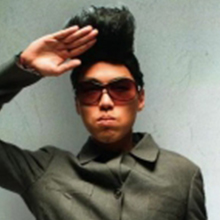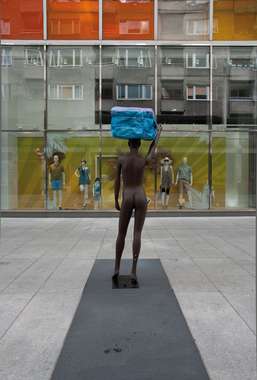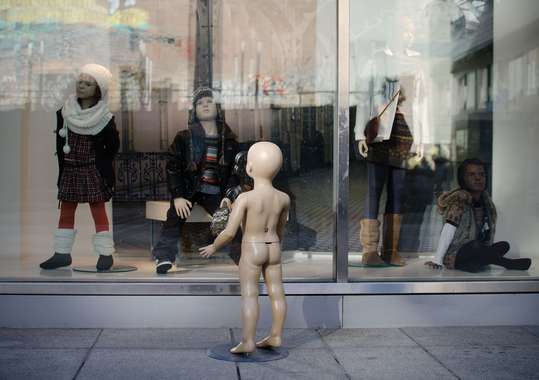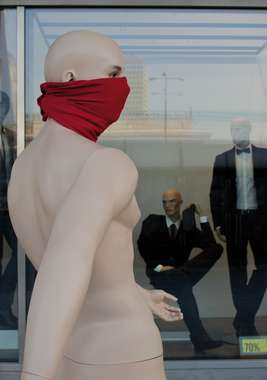On the other side of the mirror
by enero
This work has been commented by 3 curator(s). Read the comments
Title
On the other side of the mirror
Headline
A photo documentation of a series of installations
Concept author(s)
Katarzyna Pagowska
Concept author year(s) of birth
1977
Concept author(s) contribution
Author of the installations Author of the photos
Concept author(s) Country
Poland
Other author(s) Country
Poland
Friendly Competition
Competition category
Visual communication practice
Competition subcategory
static
Competition field
nonacademic
Competition subfield
artist
Subfield description
It is a photo documentation of a series of installations I realised in 2011 in public spaces of Warsaw.
Check out the Debt. 2012 outlines of Memefest Friendly competition.
Description of idea
Describe your idea and concept of your work in relation to the festival outlines:
Mannequins (representing men, women, children) are placed on the other side of a shop window, provoking discomfort, inconvenience, uncertainty, questions.
Each of the mannequins raises different questions, but they all seem to ask: is the dream of a perfect city, of a perfect life ours too? Who is born to own it? And who is born to owe?
What kind of communication approach do you use?
The mannequins are standing right here, the rest is left to you.
What are in your opinion concrete benefits to the society because of your communication?
To make one stop for a while and ask: on which side of the mirror am I at the moment? On which side of the mirror I want others to be?
Are there just two sides available; is there any option beyond the "a/symmetry" of inequality, is there any other solution beyond the mirror-like society?
What did you personally learn from creating your submitted work?
1. People's reactions when seeing the naked child were very strong.
3. I have learned that I am not the only one thinking this way.
2. I have learned that my artistic work is worth continuation.
That makes me feel alive.
Why is your work, GOOD communication WORK?
1. Because it is mine, it is honest.
2. Because the work was well prepared and realised.
It may seem a very simple and easy to implement idea, but thinking about it took me quite a long time.
3. Because it does not give easy solutions, but raises difficult questions.
4. Because, I hope, it says something crucial.
5. Because it does not harm/destroy anyone/anything.
Where and how do you intent do implement your work?
The work was realised in 2011 on the main shopping street of Warsaw. Now I hope to show photo documentation of it, whenever and wherever possible.
Did your intervention had an effect on other Media. If yes, describe the effect? (Has other media reported on it- how? Were you able to change other media with your work- how?)
Not that I know about it.
Curators Comments

Kevin Yuen Kit Lo
This is a really powerful interventionary art work. The installations are certainly shocking and thought-provoking, questioning our relationship to consumer society. The idea of inequality is very clear and pognant. Each mannequin seems to have a very powerful message, and I particularly like the "revolutionary" nature of the masked women. I really like the attention to detail, the context, postures, positioning and "accessories" are very well thought-out and resolved.
I would be very interested to know more about the project. How long were the mannequins up for, was there a reaction also from store owners or the authorities. Was there more detail to people's reactions?
It would also be helpful to see more documentation, from a greater variety of angles and compositions, and also some images including the reactions of the public perhaps.
I really appreciate your personal connection and investment to your work, and the fact that you've shared it with us. Doing something that makes one feel alive is certainly valuable in this day and age.
Congratulations.

Jason Grant
Once the fantastic silliness and humour of this subsides there is potentially a lot to engage with.
The action's relationship to the theme of debt is maybe a little tenuous/subtle, but broader questions about identity, public space, power and control in relation to consumerism are striking.
It's just a simple, spooky idea that if implemented carefully could have real impact. If documentation (video, texts etc) were available online it would greatly extend the site specific response.
Post anti-capitalism and recent UK et al riots, shopfronts are increasingly productive sites for contestation! These uninvited mannequins are trespassing just as deliberately on shopping's claim to social cohesion as the baseball bat against a window pane.
Roderick Grant
The nature of this work seems to span both its initial installation and its documentation. Of particular effect is the second of this series employing the child. While an overt commentary, I can well imagine the visceral argument posed by the mannequin on the street. The direct oppositions between need/want, have/have-not, and the resulting questioning about sock-economic status and aspiration are well established by the media employed, and the direct/objective street level view in the photography.
Late 20th Century photographers such as Thomas Struth, Harry Callahan, Gregory Crewdson and Jeff Wall often used live actors as if they were mannequins to great emotional and formal effect. Alternate points-of-view employed by these photographers bring forward sensibilities of surveillance, security, voyeurism and other issues that play around and with the central theme of debt.
The initial intervention is a successful one, but perhaps fleeting - the photography begun here shows the real potential of the project in its suspension of the moment of critique, the freezing of the instance that makes us uncomfortable.
The partial covering of the female mannequin calls into mind other potential avenues of critique to call into question what we are willing to go into debt in order to acquire...New high heels, but not pants? A new baseball cap but not diapers? New inning shoes but nothing else?
This last point also paves the way for a distinct series employing the mannequins themselves as lone actors or in combination - their power to speak for you lies in the fact that they are generic, without any real quality aside from what you assign them through interaction and intervention.







12 years, 10 months ago